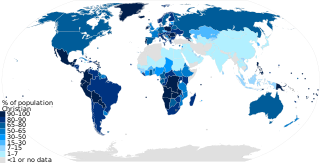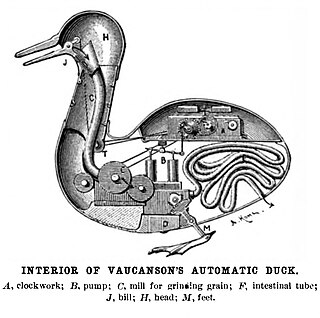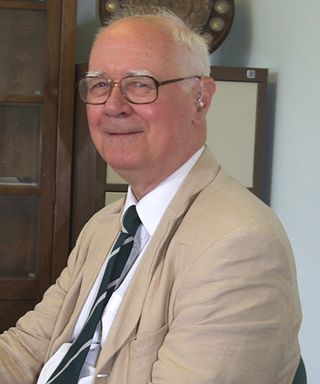
Christendom historically refers to the Christian states, Christian empires, Christian-majority countries and the countries in which Christianity dominates, prevails, or that it is culturally or historically intertwined with.
Faith, derived from Latin fides and Old French feid, is confidence or trust in a person, thing, or concept. In the context of religion, one can define faith as "belief in God or in the doctrines or teachings of religion". According to Merriam-Webster's Dictionary, faith has multiple definitions, including "something that is believed especially with strong conviction," "complete trust," "belief and trust in and loyalty to God," as well as "a firm belief in something for which there is no proof".

The relationship between religion and science involves discussions that interconnect the study of the natural world, history, philosophy, and theology. Even though the ancient and medieval worlds did not have conceptions resembling the modern understandings of "science" or of "religion", certain elements of modern ideas on the subject recur throughout history. The pair-structured phrases "religion and science" and "science and religion" first emerged in the literature during the 19th century. This coincided with the refining of "science" and of "religion" as distinct concepts in the preceding few centuries—partly due to professionalization of the sciences, the Protestant Reformation, colonization, and globalization. Since then the relationship between science and religion has been characterized in terms of "conflict", "harmony", "complexity", and "mutual independence", among others.

Reductionism is any of several related philosophical ideas regarding the associations between phenomena which can be described in terms of other simpler or more fundamental phenomena. It is also described as an intellectual and philosophical position that interprets a complex system as the sum of its parts.

John Charlton Polkinghorne was an English theoretical physicist, theologian, and Anglican priest. A prominent and leading voice explaining the relationship between science and religion, he was professor of mathematical physics at the University of Cambridge from 1968 to 1979, when he resigned his chair to study for the priesthood, becoming an ordained Anglican priest in 1982. He served as the president of Queens' College, Cambridge, from 1988 until 1996.
The relationship between Buddhism and science is a subject of contemporary discussion and debate among Buddhists, scientists and scholars of Buddhism. Historically, Buddhism encompasses many types of beliefs, traditions and practices, so it is difficult to assert any single "Buddhism" in relation to science. Similarly, the issue of what "science" refers to remains a subject of debate, and there is no single view on this issue. Those who compare science with Buddhism may use "science" to refer to "a method of sober and rational investigation" or may refer to specific scientific theories, methods or technologies.
Mehdi Golshani is a contemporary Iranian theoretical physicist, academic, scholar, philosopher and distinguished professor at Sharif University of Technology. He is also member of Iranian Science and Culture Hall of Fame, senior fellow of Academy of Sciences of Iran and a founding fellow of the Institute for Studies in Theoretical Physics and Mathematics. He is a former member of the Supreme Council of the Cultural Revolution.
In philosophy, theophysics is an approach to cosmology that attempts to reconcile physical cosmology and religious cosmology. It is related to physicotheology, the difference between them being that the aim of physicotheology is to derive theology from physics, whereas that of theophysics is to unify physics and theology.

Christian Heinrich Arthur Drews was a German writer, historian, philosopher, and important representative of German monist thought. He was born in Uetersen, Holstein, in present-day Germany.
Muslim scholars have developed a spectrum of viewpoints on science within the context of Islam. The Quran and Islam allows much interpretation when it comes to science. Scientists of medieval Muslim civilization contributed to the new discoveries in science. From the eighth to fifteenth century, Muslim mathematicians and astronomers furthered the development of almost all areas of mathematics. At the same time, concerns have been raised about the lack of scientific literacy in parts of the modern Muslim world.
Faith, Science, and Understanding is a book by John Polkinghorne which explores aspects of the integration between science and theology. It is based on lectures he gave at the University of Nottingham and Yale and on some other papers.

God in Christianity is believed to be the eternal, supreme being who created and preserves all things. Christians believe in a monotheistic conception of God, which is both transcendent and immanent. Christian teachings on the transcendence, immanence, and involvement of God in the world and his love for humanity exclude the belief that God is of the same substance as the created universe but accept that God the Son assumed hypostatically united human nature, thus becoming man in a unique event known as "the Incarnation".
Since the emergence of the Big Bang theory as the dominant physical cosmological paradigm, there have been a variety of reactions by religious groups regarding its implications for religious cosmologies. Some accept the scientific evidence at face value, some seek to harmonize the Big Bang with their religious tenets, and some reject or ignore the evidence for the Big Bang theory.

Issues in Science and Religion is a book by Ian Barbour. A biography provided by the John Templeton Foundation and published by PBS online states this book "has been credited with literally creating the contemporary field of science and religion."

William Grosvenor Pollard (1911–1989) was an American physicist and an Episcopal priest. He started his career as a professor of physics in 1936 at the University of Tennessee. In 1946 he championed the organization of the Oak Ridge Institute of Nuclear Studies (ORINS). He was its executive director until 1974. He was ordained as a priest in 1954. He authored and co-authored a significant amount of material in the areas of Christianity and Science and Religion found in books, book chapters, and journal articles. He was sometimes referred to as the "atomic deacon".

Questions of Truth is a book by John Polkinghorne and Nicholas Beale which offers their responses to 51 questions about science and religion. The foreword is contributed by Antony Hewish.
Christian agnosticism is a theological position drawing influences from Christianity as well as agnosticism. Christian agnostics hold that it is difficult or impossible to be sure of anything beyond the basic tenets of the Christian faith. They believe that God or a higher power might exist, that Jesus may have a special relationship with God, might in some way be divine, and that God might perhaps be worshipped. This belief system has deep roots in the early days of the Church.

Most scientific and technical innovations prior to the scientific revolution were achieved by societies organized by religious traditions. Ancient pagan, Islamic, and Christian scholars pioneered individual elements of the scientific method. Historically, Christianity has been and still is a patron of sciences. It has been prolific in the foundation of schools, universities and hospitals, and many Christian clergy have been active in the sciences, and have made significant contributions to the development of science.










